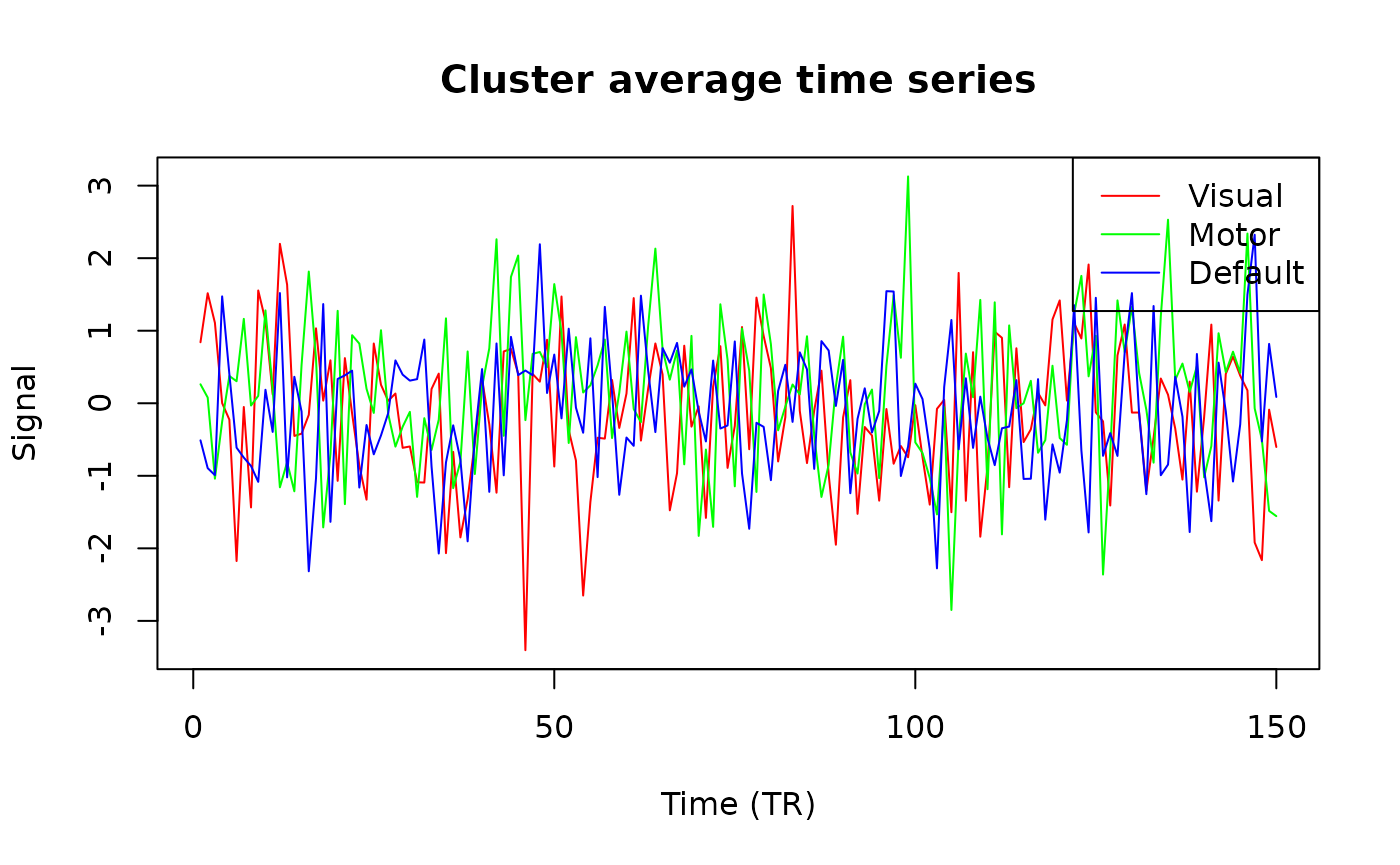Working with Clustered fMRI Data: H5ClusterExperiment
fmristore Package
2025-06-25
Source:vignettes/H5ClusterExperiment.Rmd
H5ClusterExperiment.Rmd
library(fmristore)
#>
#> Attaching package: 'fmristore'
#> The following object is masked from 'package:stats':
#>
#> offset
library(neuroim2)
#> Loading required package: Matrix
#>
#> Attaching package: 'neuroim2'
#> The following object is masked from 'package:base':
#>
#> scaleOverview
The H5ClusterExperiment class provides an efficient way
to store and access multi-run fMRI data that has been organized by
spatial clusters (e.g., brain parcels or regions). This approach is
particularly useful when:
- You have multiple fMRI runs from the same or different subjects
- Your data has been parcellated using an atlas or clustering algorithm
- You want efficient access to time series from specific brain regions
- You need to store both full voxel-level data and summary statistics
Key Concepts
What is Clustered Data?
Instead of storing fMRI data as a regular 4D array (x, y, z, time), clustered storage groups voxels by their cluster membership. This provides:
- Faster access to all voxels within a brain region
- Efficient storage through better compression of similar signals
- Flexible analysis at both voxel and region levels
Creating an H5ClusterExperiment
Let’s start with a simple example using simulated data.
Step 1: Define the Brain Space
# Create a small brain volume (10x10x5 voxels)
brain_dim <- c(10, 10, 5)
brain_space <- NeuroSpace(brain_dim, spacing = c(2, 2, 2))
# Create a mask (which voxels contain brain tissue)
mask_data <- array(FALSE, brain_dim)
mask_data[3:8, 3:8, 2:4] <- TRUE # Simple box-shaped "brain"
mask <- LogicalNeuroVol(mask_data, brain_space)
cat("Number of brain voxels:", sum(mask), "\n")
#> Number of brain voxels: 108Step 2: Define Clusters
# Create 3 clusters within the mask
n_voxels <- sum(mask)
cluster_ids <- rep(1:3, length.out = n_voxels)
# Create the clustered volume
clusters <- ClusteredNeuroVol(mask, cluster_ids)
# Check cluster sizes
table(clusters@clusters)
#>
#> 1 2 3
#> 36 36 36Step 3: Prepare Run Data
Now let’s create data for two fMRI runs - one with full voxel data and one with summary data.
# Run 1: Full voxel-level data
n_timepoints_run1 <- 100
# Create data for each cluster
run1_data <- list()
for (cid in 1:3) {
voxels_in_cluster <- sum(clusters@clusters == cid)
# Simulate time series with cluster-specific patterns
run1_data[[paste0("cluster_", cid)]] <-
matrix(rnorm(voxels_in_cluster * n_timepoints_run1,
mean = cid), # Different mean for each cluster
nrow = voxels_in_cluster,
ncol = n_timepoints_run1)
}
# Run 2: Summary data (averaged time series per cluster)
n_timepoints_run2 <- 150
run2_data <- matrix(rnorm(n_timepoints_run2 * 3),
nrow = n_timepoints_run2,
ncol = 3)Step 4: Create Metadata
# Metadata for each run
run1_metadata <- list(
subject_id = "sub-01",
task = "rest",
TR = 2.0
)
run2_metadata <- list(
subject_id = "sub-01",
task = "motor",
TR = 2.0
)
# Cluster metadata
cluster_metadata <- data.frame(
cluster_id = 1:3,
name = c("Visual", "Motor", "Default"),
color = c("red", "green", "blue")
)Step 5: Write to HDF5
# Prepare the runs data structure
runs_data <- list(
list(
scan_name = "rest_run",
type = "full",
data = run1_data,
metadata = run1_metadata
),
list(
scan_name = "motor_run",
type = "summary",
data = run2_data,
metadata = run2_metadata
)
)
# Write to HDF5
h5_file <- tempfile(fileext = ".h5")
write_clustered_experiment_h5(
filepath = h5_file,
mask = mask,
clusters = clusters,
runs_data = runs_data,
cluster_metadata = cluster_metadata,
overwrite = TRUE,
verbose = FALSE
)Reading and Using H5ClusterExperiment
Loading the Data
# Create H5ClusterExperiment object
experiment <- H5ClusterExperiment(h5_file)
#> Clusters argument is NULL, attempting to read from HDF5 file (/cluster_map).
# Basic information
experiment
#>
#> H5ClusterExperiment
#> # runs : 2
#> # clusters : 3
#> mask dims : 10x10x5
#> HDF5 file : /tmp/RtmpRhIeyj/file2174393ebdec.h5Accessing Metadata
# Scan names
cat("Available scans:", paste(scan_names(experiment), collapse = ", "), "\n")
#> Available scans: motor_run, rest_run
# Number of scans
cat("Total scans:", n_scans(experiment), "\n")
#> Total scans: 2
# Cluster information
cluster_info <- cluster_metadata(experiment)
print(cluster_info)
#> cluster_id color name
#> 1 1 red Visual
#> 2 2 green Motor
#> 3 3 blue Default
# Scan-specific metadata
scan_meta <- scan_metadata(experiment)
cat("\nRest run TR:", scan_meta$rest_run$TR, "seconds\n")
#>
#> Rest run TR: 2 secondsExtracting Time Series
Extract time series for specific voxels:
# Get time series for the first 5 voxels
voxel_indices <- 1:5
ts_data <- series(rest_run, i = voxel_indices)
dim(ts_data) # timepoints x voxels
#> [1] 100 5
# Plot one voxel's time series
plot(ts_data[, 1], type = "l",
main = "Time series for voxel 1",
xlab = "Time (TR)", ylab = "Signal")
Concatenating Across Runs
Combine time series from multiple runs:
# Check which runs are available and their types
for (i in seq_along(experiment@runs)) {
run <- experiment@runs[[i]]
cat(sprintf("Run %d: %s (type: %s)\n", i, run@scan_name, class(run)[1]))
}
#> Run 1: motor_run (type: H5ClusterRunSummary)
#> Run 2: rest_run (type: H5ClusterRun)
# Get time series from full runs only
# Find which run indices correspond to H5ClusterRun (full data)
full_run_indices <- which(sapply(experiment@runs, function(r) is(r, "H5ClusterRun")))
if (length(full_run_indices) > 0) {
all_ts <- series_concat(experiment,
mask_idx = 1:3,
run_indices = full_run_indices[1]) # Use first full run
cat("Concatenated dimensions:", dim(all_ts), "\n")
} else {
cat("No full runs available for voxel-level extraction\n")
}
#> Concatenated dimensions: 100 3Working with Summary Data
# Access the summary run
motor_run <- experiment@runs[["motor_run"]]
class(motor_run)
#> [1] "H5ClusterRunSummary"
#> attr(,"package")
#> [1] "fmristore"
# Get the summary matrix
summary_matrix <- as.matrix(motor_run)
dim(summary_matrix) # timepoints x clusters
#> [1] 150 3
# Plot average time series for each cluster
matplot(summary_matrix, type = "l", lty = 1,
col = cluster_info$color,
main = "Cluster average time series",
xlab = "Time (TR)", ylab = "Signal")
legend("topright", legend = cluster_info$name,
col = cluster_info$color, lty = 1)
Memory Efficiency
The H5ClusterExperiment design provides several memory advantages:
- Lazy loading: Data is only read when accessed
- Partial reading: Can extract specific voxels or time ranges
- Efficient storage: Similar signals are stored together
# Check file size
file_size_mb <- file.info(h5_file)$size / 1024^2
cat("HDF5 file size:", round(file_size_mb, 2), "MB\n")
#> HDF5 file size: 0.07 MB
# Memory usage of a specific extraction
object.size(ts_data) |> format(units = "Kb")
#> [1] "4.1 Kb"Best Practices
- Organize by similarity: Clusters should group functionally similar voxels
- Use summary runs: For analyses that only need regional averages
- Chunk appropriately: HDF5 chunking affects read performance
- Close when done: Always close the HDF5 file handle
Next Steps
- See
vignette("H5Neuro")for working with unclustered data - Explore
LatentNeuroVecfor dimensionality-reduced representations - Check the package documentation for advanced features